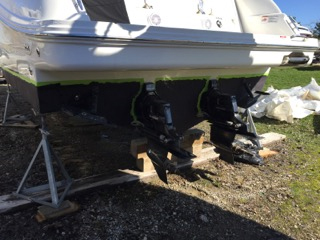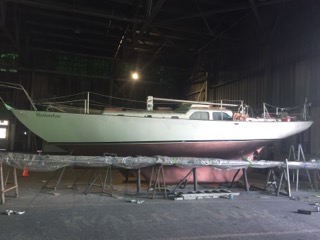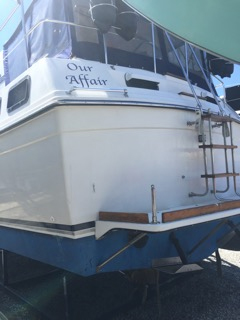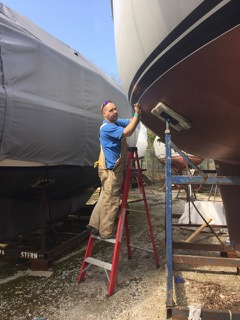Ask Andrew: Getting to the bottom of antifouling

Mar 8, 2018
I once heard an argument at a yacht club. Two old salts, patiently itching to let go lines and raise sail were preparing their boats for launch. The argument went something like this:
Micron CSC applied to the hull and transom, with an inch-gap around the stern-drives
“What kind of antifoul are you using this year?” asked the first.
“It’s AntifoulingPaint”, came the reply.
“Yes, but what kind of antifoul?” pressed the first.
“Paint. For Antifouling”, was the exasperated response.
 Fresh VC17 on a sailboat just prior to launch
Fresh VC17 on a sailboat just prior to launch
It was clear to me that the two boat owners were more concerned with semantics than function. I hope that the argument can finally be put to rest, with this article on Antifoul. Antifouling. Paint. Same thing.
Whether you call it antifoul, antifouling, or antifouling paint, it all amounts to the same function: treatment of a boat’s hull with a paint or similar substance designed to prevent fouling. Fouling is the accumulation of microorganisms, plants, algae or animals on wetted surfaces. Antifouling paint is applied to prevent this build-up.
This fouling build-up poses problems for watercraft: damage to hull and propulsion systems and efficiency of movement. In extreme cases, accumulation of biofoulers on hulls can increase the vessel’s surface area and friction, leading to increased drag up to 60%. This drag can decrease speed by 10%, and can require up to a 40% increase in fuel consumption to compensate.
micron-csc-on-hull-320.jpg caption: Micron CSC applied to the hull and transom, with an inch-gap around the stern-drives
Racing sailors tremble at the thought of losing 10% hull speed, and power-boaters break out into sweat at the thought of paying 40% more in fuel. Suffice to say: Antifouling is an important process to take, prior to launch.
And we’re not the first to have this conversation. It’s been happening for some 300 years. The first recorded antifouling process was the use of copper plating to sheathe the keel and underwater planking of HMS Alarm in 1761. The copper sheathing was successful in preventing wood-boring worms from damaging the hull, and also prevented the growth of weeds, as the copper produced a oxychloride film when immersed in water. Around 1770, the Royal Navy sheathed the entire fleet! Over time, as more iron was used in ship production, copper sheathing became impracticable, due to galvanic corrosion. Relatively ineffective and expensive paints were developed in the late nineteenth century, but it wasn’t until the 1960’s that the modern version of antifouling was developed: a paint which is self-polishing, and uses seawater’s ability to react with the paint and release antifouling chemicals at a slow and controlled rate. Additionally, the combination of ingredients in modern antifouls prevent any copper present from reacting to other metals present – so galvanic corrosion caused by antifouling is of little concern.
 Second-year bottom paint – some noticeable wear, but good for another season
Second-year bottom paint – some noticeable wear, but good for another season
Many breakthroughs have taken place in the last 50 years and today we have many brands, types, chemical compositions and colours to suit every type of boat and boater.
Lets break down the types available and their uses:
Two major divisions can be seen: Hard and Soft.
A hard antifoul gives a solid coat that is smooth, thin and hard to the touch – it needs to be scratched, scraped or sanded to remove. Hard antifouls should be applied just before launch, and are rendered ineffective if the boat is removed and relaunched repeatedly. Hard antifouls typically last one season only. Example: VC17
A soft antifoul looks and acts like a layer of paint, it can be removed with a heavy blast of a power washer, and many brands work well on boats that are trailerable and removed from the water and re-launched during the season. Soft antifouls often last multiple seasons. Example: Micron CSC
A decade ago, it was fairly easy to simplify the difference: Hard antifoul for racing sailboats – boats that want as little drag and as smooth a hull surface as possible. Soft antifouls for trailerable boats (sail and power), larger power boats, and sail-boaters who want multi-season protection at the cost of racing speed.
I would suggest this as a place to start – but recent years have added more elements to the mix, including:
– Water based paints – marketed as the most environmentally friendly option
– Copper or non-copper bases (copper being the traditional base to prevent fouling)
– Single vs multi-season protection
– Colour options
– Compatibility with other brands or types of antifoul
– Hull type – wood, fibreglass, steel or aluminum
So – How do you choose which antifoul is right for you?
Start with the type of boat and the way that it’s used: Are you a racer? Cruiser? Does your boat sit at dock more often than not? Freshwater? Salt Water? Is the boat in the water throughout the sailing season or does it come in and out on a trailer or cradle? Is the boat in the water year-round, or is an extended voyage planned?
Next: What type of hull do you have? A bare gelcoat hull will require a layer between the gelcoat and the antifouling (called a ‘barrier coat’, and acts as a primer as provides protection from osmotic blistering). Is there existing antifouling on the hull? If so, some prep work may be in order, or you may choose to apply an antifoul that is designed to go over other types/brands of antifoul. Metal hulls (especially aluminum) typically require an epoxy-type primer prior to applying antifoul
Finally – Coverage, cost and colour. Some antifouls have larger coverage for the same size of paint can (ie it will cover more boat hull than a competitor), but this may not mean a cost savings overall. Run some comparisons if you’re on a strict budget. Blue, green, red and black are quite common amongst competing brands. Pro tip: paint two coats with two different colours. As the top coat wears off over time, the second coat (in a different colour) will be exposed, giving you an easy view of the state of your antifoul when looking at the hull in the off-season.
Antifoul application instructions are dictated by the manufacturer. Each type of antifoul has specific application instructions, including surface preparation, compatibility with other antifouls already on the hull, time of application (sometimes it must be done 12 hours before launch), ambient temperature at the time of application. I encourage you to read and understand the instructions before application – these factors really do matter, and can make the difference between solid protection and a botched job that cracks and peels off the hull. Removing tape after completing the work.
Removing tape after completing the work.
If you’re applying antifoul by yourself, be mindful of the safety instructions indicated by the manufacturer. Most of these products are chemical and/or metal based, and exposure can be harmful to humans. Do not breathe fumes or dust, wear a respirator, gloves and eye-protection. Many marinas and yacht clubs will not allow hulls with antifoul to be sanded on the premises (due to the toxic nature of the dust, and the ease with which the dust sticks to and damages any fibreglass that it lands on!). Those marinas and clubs that do allow hull sanding require the area to be properly tarped, shielded and cleaned up thoroughly after work. Check with your yard before beginning work.
Now is a great time to begin your research before the spring rush. You may want to take a good look at your hull to determine what it needs to move forward into 2018, and the type/cost and availability of your preferred antifoul. Look at yard regulations, safety and application instructions. If you’re hoping to hire someone to do the work for you, get in touch soon, as bookings fill up fast as warm weather hits.
Safe and Happy boating!
 Andrew McDonald is the owner of Lakeside Marine Services – a boat repair/maintenance firm based in Toronto. Andrew has worked in the marine industry for 12 years and is a graduate of the Georgian College ‘Mechanical Techniques – Marine Engine Mechanic’ program.
Andrew McDonald is the owner of Lakeside Marine Services – a boat repair/maintenance firm based in Toronto. Andrew has worked in the marine industry for 12 years and is a graduate of the Georgian College ‘Mechanical Techniques – Marine Engine Mechanic’ program.
Questions or comments for Andrew? Email him directly via: askandrew@lakesidemarineservices.ca




























